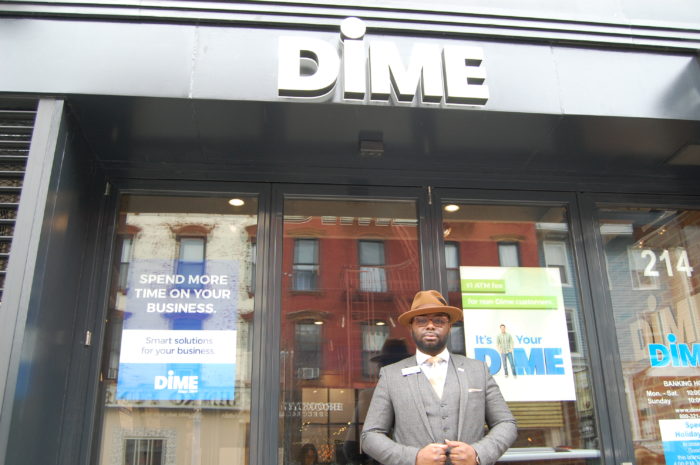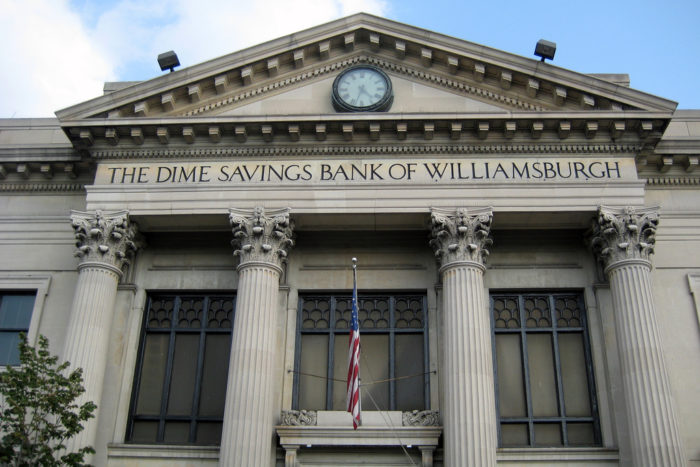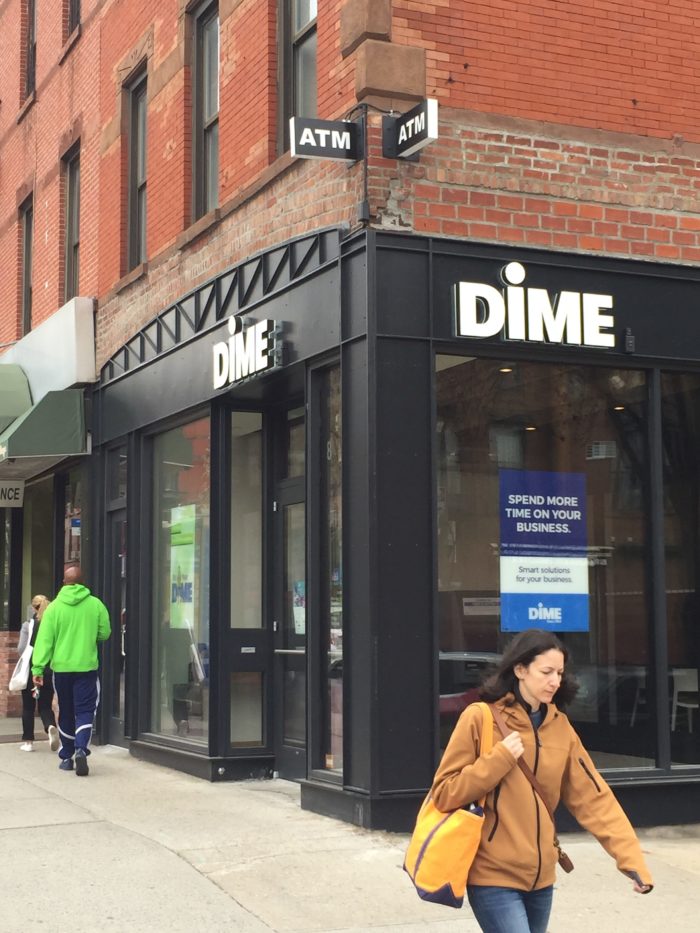Anthony Wilson doesn’t see himself as a traditional banker.
That’s partly a matter of style. In his dapper three-piece suit and fedora, Wilson, the manager of Dime Community Bank’s branch on Bedford Avenue, fits perfectly in the boho vibe of the surrounding Williamsburg neighborhood.
“I’m a banker with a hat,” he says.
More importantly, though, it’s about his daily interactions with the local business community. Wilson presides over a 433-sq.-ft. storefront that—with its rustic wood cabinetry, Mason-jar light fixtures, and six kinds of coffee at the self-service sideboard—looks less like a bank than an indie cafe.
His “office,” meanwhile, is little more than a nook. But that’s just as well, because the 36-year-old Brooklyn native says his real job is to leave his desk and get to know the business owners up and down the thriving commercial corridor outside.
“If I walk outside on Bedford and at least four people don’t say hello, I’m not doing my job,” he says.

Manager Wilson prides himself on his fedora and his folksy manner with nearby Williamsburg merchants (Photo by Steve Koepp)
The Bank Gets a Makeover
Indeed, Dime’s top brass is asking Wilson and his fellow branch managers to drive a reinvention of the 150-year-old institution. In recent decades, the bank—known until August as Dime Savings Bank of Williamsburgh (yes, it was spelled that way back then)—focused nearly all its lending on multi-family residential real estate.
Now it hopes to transform itself into a broader-based community bank, in large part by convincing mom-and-pop business—dry cleaners, pizzerias, nail salons, bodegas, boutiques and the like—to do their commercial banking at Dime.
If Wilson and his fellow managers are on the front lines of that effort, CEO Kenneth Mahon, a 37-year Dime veteran who became CEO in January, is the chief strategist. Sitting in a modest conference room at Dime’s Cadman Plaza headquarters last month, Mahon said his first step was developing products, like lines of credit, that small businesses use to stay afloat. “Until now we didn’t have the credit facilities that these folks need,” he explained. “Small business people need liquidity. They need financing for receivables. They have cash flow needs, month in, month out.”

The bank was founded in 1864; its main branch is this edifice on Havemeyer Street (Photo by Wally Gobetz/flickr)
Earlier this year, Mahon kick-started his plan by hiring a team of nearly a dozen credit experts to build out Dime’s small-business operation. And he began bulking up the firm’s retail presence. The addition of three new branches in the past few months—Wilson’s Bedford Avenue branch, another Williamsburg location, and one on 5th Avenue in Park Slope—brings Dime’s total to 28 in the New York metro area.
Mahon envisions the new branches as community spaces, each tailored to sensibilities of their respective neighborhoods. Thus the coffee-shop décor and free wifi in Williamsburg, and the use of “locally sourced materials” in Park Slope. “For a long time, Dime took the retail end of the business for granted,” Mahon admits. “We need to transform this place into something relevant to the 21st century.”
Dime has thrived in its real-estate niche for decades, so why the sudden shift in strategy?
One reason, of course, is growth. With about $6 billion in assets, Dime is bigger than a typical community bank but a rounding error compared to industry giants like JPMorgan Chase and Bank of America, which each have more than $2 trillion on their books. Still, Mahon says banking regulators won’t let Dime get any bigger if it doesn’t diversify its loan portfolio. (The bank’s holding company, Dime Community Bancshares, trades on NASDAQ as DCOM.)
Looking for Local Depositors
Then there’s the fact that Dime’s core lending business doesn’t deliver much in the way of deposits. To help fund its multifamily loans, Dime has instead relied on online money-market accounts, which it markets with nationally competitive rates at sites like Bankrate.com. That model works well with interest rates low, but rising rates, likely in the years ahead, would put a squeeze on margins.

The bank’s new branch in Park Slope was decorated with “locally sourced materials” (Photo by Steve Koepp)
Small-business banking, by contrast, is a “more encompassing” relationship that brings deposits in the door, says Collyn Gilbert, a senior analyst who covers Dime for investment bank Keefe, Bruyette & Woods. And those funds are less sensitive to interest rates.
Small-business lending would also protect Dime if the residential real-estate market softens—something Mahon suspects is likely. “I’ve been through four or five construction downturns in my career,” he says, “and right now feels like we’re heading into another one.” Gilbert agrees. “Coming off a low-rate environment calls into question what the real-estate market will look like in the next five to ten years,” she says. “A small-business focus allows Dime to hedge against that uncertainty.”
The trick now is to turn local small businesses, unaccustomed to seeing Dime as a business banking option, into customers. Marketing efforts like sponsorship of next month’s Dime McCarren 5K Run will help. But branch managers like Wilson will do the heavy lifting. Mahon, who sits on the board of Los Sures, a prominent Williamsburg social-services non-profit, has charged them with getting involved in their local communities.
Wilson, whose immigrant father still runs the Brooklyn plumbing-and-heating business he founded 30 years ago, is happy to comply. “I’m a people person, and I was the product of a small business family,” he says. “I don’t believe in selling anything. I believe in making a connection. If I do that, you’ll remember me when you need me. That’s what we do.”